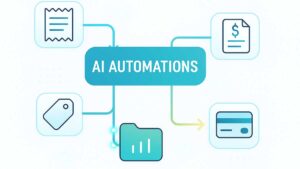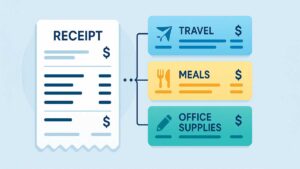Why Canadian Receipts Often Show Two Taxes
For many individuals and businesses, Canadian taxes can feel confusing. Unlike some countries that have a single national tax, Canada uses both a federal tax system and provincial tax systems. This means the same purchase can be taxed in different ways depending on where you live or operate your business.
For freelancers and small business owners, this complexity makes managing receipts and reporting taxes especially challenging. However, once you break it down, the Canadian tax structure becomes easier to understand.
In this article, we’ll explain the three main types of sales taxes in Canada, why receipts often show two different taxes, and how SparkReceipt helps you keep them organized for reporting.
The Three Main Types of Canadian Sales Taxes
Canada’s tax system combines federal and provincial taxes. Here’s a simple overview:
- GST (Goods and Services Tax): A federal tax of 5% applied to most goods and services across Canada.
- PST (Provincial Sales Tax): A tax set by each province, with different rates and rules. It has different names depending on the region:
- QST (Quebec Sales Tax) in Quebec.
- RST (Retail Sales Tax) in Manitoba.
- HST (Harmonized Sales Tax): A combined tax that merges GST and PST into a single rate. Provinces like Ontario, New Brunswick, Nova Scotia, Newfoundland and Labrador, and Prince Edward Island use HST to simplify collection.
In short: depending on the province, you may see GST, PST/QST/RST, or HST on your receipt.
Why Canadian Receipts Often Show Two Taxes
If you’ve ever looked at a Canadian receipt and wondered “why are there two taxes?”, you’re not alone. This happens because both federal and provincial governments can apply their own tax.
For example:
- In British Columbia, receipts often show GST + PST.
- In Quebec, you’ll see TPS (federal GST) + TVQ (provincial QST).
- In Ontario, everything is rolled together into HST.
This dual system is part of what makes Canadian receipts unique. It also explains why businesses – especially freelancers and small business owners – need to track expenses carefully to stay compliant.
The Challenge for Freelancers and Small Businesses
Managing GST and PST is not as simple as just adding them up. Each tax has its own registration, reporting, and payment requirements.
- GST/HST: Businesses and freelancers must register with the Canada Revenue Agency (CRA) once revenue passes a certain threshold. They collect GST/HST on sales and file returns monthly, quarterly, or annually.
- PST/QST: Provinces run their own systems. For example, in British Columbia, many freelancers selling taxable services must register for PST and remit it to the BC Ministry of Finance.
Because the rules differ between provinces, you may need to register twice, track two tax amounts, and file reports to two different authorities. Without a proper system, this can quickly become overwhelming.
How SparkReceipt Helps With Canada’s Dual Tax System
At SparkReceipt, we know that Canada’s tax structure is more complex than most. That’s why our app is designed to handle dual taxes automatically.
- When you scan a Canadian receipt, SparkReceipt can detect both tax types (for example, GST and PST).
- In Quebec, SparkReceipt recognizes French tax codes such as TPS and TVQ.
- The app then splits the two amounts so you can track them separately in your records.
The result: no more manual sorting, no more confusion over which tax was applied, and no risk of missing amounts during tax season.
Streamlined Reporting Made Simple
Tracking taxes is only half the job. The other half is reporting them correctly.
- SparkReceipt’s reports clearly separate GST and PST amounts.
- You can export Excel or PDF files with tax breakdowns, making it easier to file with both the CRA and your provincial tax authority.
- This means freelancers and small businesses can stay compliant without spending hours organizing receipts.
In other words, SparkReceipt turns a complicated dual-tax system into something simple and manageable.
Conclusion
Canada’s tax system may look complicated at first, with its mix of GST, PST/QST, and HST. Receipts often show two taxes, which adds another layer of complexity for freelancers and small businesses.
However, with the right tools, this doesn’t have to be stressful. SparkReceipt automatically detects, splits, and organizes Canadian taxes – making compliance faster and easier.
If you’re tired of wrestling with GST and PST, give SparkReceipt a try and simplify your Canadian tax tracking.




